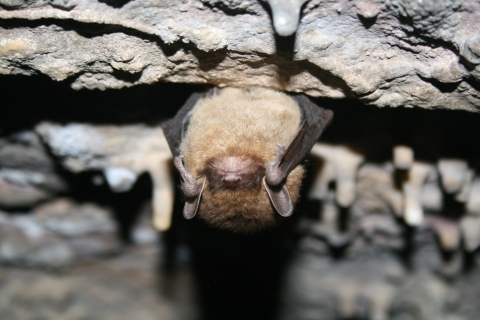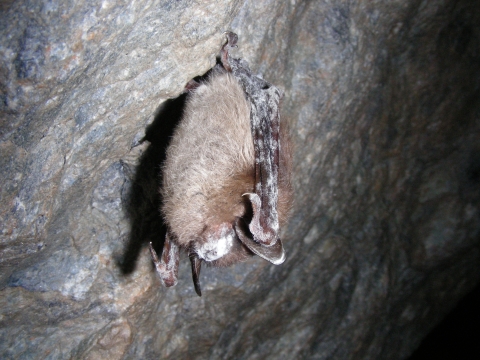What’s brown, fuzzy, and provides us all a service every single night without any expectation of a thank you or reward? A bat!
Of the seven bat species that have been documented in Alaska, the little brown bat (Myotis lucifugus) is by far the most common and widespread, from southeast Alaska to the northern Interior and down to southcentral and western Alaska.
One little brown bat can eat over 600 mosquitos in a single hour, or more than its weight in insects every night. It is estimated that bats contribute the equivalent of $4 billion worth of pest control for U.S. farmers. Many of the insects bats eat also carry diseases, like West Nile Virus and malaria. As if that’s not enough reason to love bats already, they are also excellent pollinators.
Bats and bears on an island oasis
Kodiak Island, home to Kodiak National Wildlife Refuge, is world famous for its massive Kodiak brown bears. The little brown bat weighs in at a fraction of the size, but also plays a vital role in the local ecosystem. While we have learned quite a bit about brown bears, we know much less about the unassuming brown, furry mammal of the sky.
Despite all their beneficial services and cute batty ears, little brown bats across much of Alaska remain a bit mysterious. On Kodiak, we don’t have an estimate of their population, where they roost during the day, or whether they migrate off island or hibernate locally between November and April. Finding answers to these questions may become even more important as populations of bats in the lower-48 experience dramatic declines due to a fungal infection, called white nose syndrome, that is likely to make its way to Alaska eventually.
What is White Nose Syndrome?
White nose syndrome (WNS) is a fungal disease that was discovered in New York in 2006 and has since spread to 37 states and 7 Canadian provinces wiping out millions of bats as it goes. WNS makes hibernating bats use more energy and wake up more frequently during the winter causing them to starve to death before spring arrives. Populations of bats affected by the disease can see up to a 90% decline in their numbers.
The more we can learn about little brown bats in Kodiak the better chance we have of preventing WNS from reaching the archipelago and infecting our bats. Kodiak National Wildlife Refuge staff are hoping to unravel some of the mysteries of little brown bats in the coming years using a variety of survey techniques.
How do you study a tiny animal that only comes out at night?
Some of the techniques we can use to count and track populations of bats in Kodiak include: emergence counts, acoustic monitoring, and mist-net surveys. Emergence counts are simple: they just require a dedicated volunteer to wait outside a known roost and count the number of bats that emerge. Acoustic monitoring of bats requires a bat detector device that picks up bat echolocation calls, which are inaudible to human ears, in order to count the number of bats in an area. Mist-net surveys involve hanging specialized nets in areas of high bat traffic so the bats can be captured, tagged, and released. Bats captured while mist-netting can be tagged with a numbered ring on their leg and then recaptured at a later date to gain an accurate count of the number of bats in the area. This is a survey technique called capture-mark-recapture. Alternatively, captured bats can be fitted with a tiny radio transmitter and tracked remotely on foot or by airplane.
How can I get involved?
If you live in the Kodiak area, there may be opportunities to help monitor and study the local bat population. Contact Erin Strand, Kodiak Refuge Volunteer Coordinator, at erin_strand@fws.gov.





